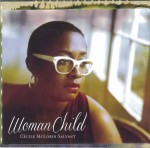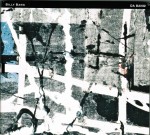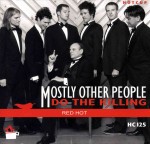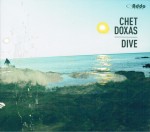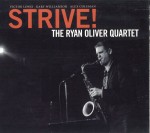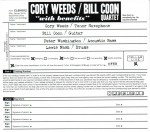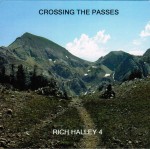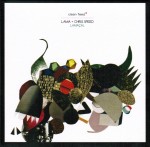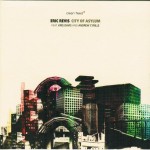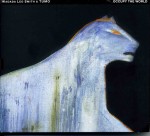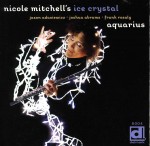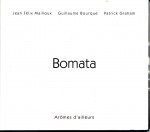Something in the Air Good Music Comes in Many Forms and Formats
Standardization is a thing of the past when it comes to recorded music and listeners who get too far ahead of, or behind, the curve are likely to miss interesting sounds. Just as the production of movies didn’t cease with the acceptance of television, so the manufacture of LPs continued even as the CD became the format of the moment. As artisans continue to craft fine furniture despite the availability of mass-produced items, so too LPs are being created in limited quantities. This situation appears tailor-made for experimental sounds. Similarly since advanced players are often as impecunious as they are inventive, the ubiquity of the Internet means that some music is only sold digitally through the Web. The option of not having to create a physical product is a boon for non-mainstream performers.
 Probably the most spectacular recent example of vinyl-only releases is Just Not Cricket: Three Days of Improvised Music in Berlin (Ni-Vu-Ni-Connu nvnc lp001/004, ni-vu-ni-connu.net). A four-LP set pressed on 180-gram virgin vinyl, the box set also includes a copy of the festival’s lavishly illustrated full-colour program plus a 20-page, LP-sized booklet featuring black and white photographs from the event, an essay about Free Music, plus a transcribed conversation with the 16 British artists who participated. As much an artifact as a musical keepsake, Just Not Cricket showcases many of BritImprov’s most important players. With a cast of characters ranging from Free Music pioneers such as saxophonist Trevor Watts and percussionist Eddie Prévost to younger stylists including trumpeter Tom Arthurs and saxophonist Shabaka Hutchings, plus representation of the so-called Second Wave such as pianist Steve Beresford and harpist Rhodri Davies, the selection is all-embracing as well as varied. There’s high-quality music represented by all three groups. Prévost’s duet with saxophonist Lol Coxhill, for instance, demonstrates that by maintaining the proper pulse, an atonal reed and percussion duet can suggest Benny Goodman and Gene Krupa while still outputting kazoo-like blats and scattered drum pumps. Energetic and atonal, a blow-out featuring players such as Arthurs, Hutchings, guitarist Alex Ward, bassist John Edwards and drummer Mark Sanders, is invested with Free Jazz energy. Yet among the freak brassy triplets, saxophone honks and near slack-key guitar lines, Ward’s comping, Edwards’ robust bowing and Sanders perfectly timed accents turn bluster into satisfying sonic alliances. There are also elements of humour, most apparent the moment Beresford’s slick keyboard glissandi turn to kinetic smacks and splashes replicating both bebop and lounge piano playing, as Edwards’ pumps and trombonist Gail Brand’s wide snorts and flutters add a layer of laughing euphoria to this trio interaction. Other highlights include bass saxophonist Tony Bevan using his widening cavernous resonations to create perfect counterpoint to the rhythms from dual bassists Edwards and Dominic Lash; while on another track, Watts’ splintering alto saxophone intensity is brought to a higher level as horizontal sticks vibrations among Davies’ harp strings and Orphy Robinson’s ringing vibraphone licks produce more polyrhythms than would be found in an orchestra’s percussion section.
Probably the most spectacular recent example of vinyl-only releases is Just Not Cricket: Three Days of Improvised Music in Berlin (Ni-Vu-Ni-Connu nvnc lp001/004, ni-vu-ni-connu.net). A four-LP set pressed on 180-gram virgin vinyl, the box set also includes a copy of the festival’s lavishly illustrated full-colour program plus a 20-page, LP-sized booklet featuring black and white photographs from the event, an essay about Free Music, plus a transcribed conversation with the 16 British artists who participated. As much an artifact as a musical keepsake, Just Not Cricket showcases many of BritImprov’s most important players. With a cast of characters ranging from Free Music pioneers such as saxophonist Trevor Watts and percussionist Eddie Prévost to younger stylists including trumpeter Tom Arthurs and saxophonist Shabaka Hutchings, plus representation of the so-called Second Wave such as pianist Steve Beresford and harpist Rhodri Davies, the selection is all-embracing as well as varied. There’s high-quality music represented by all three groups. Prévost’s duet with saxophonist Lol Coxhill, for instance, demonstrates that by maintaining the proper pulse, an atonal reed and percussion duet can suggest Benny Goodman and Gene Krupa while still outputting kazoo-like blats and scattered drum pumps. Energetic and atonal, a blow-out featuring players such as Arthurs, Hutchings, guitarist Alex Ward, bassist John Edwards and drummer Mark Sanders, is invested with Free Jazz energy. Yet among the freak brassy triplets, saxophone honks and near slack-key guitar lines, Ward’s comping, Edwards’ robust bowing and Sanders perfectly timed accents turn bluster into satisfying sonic alliances. There are also elements of humour, most apparent the moment Beresford’s slick keyboard glissandi turn to kinetic smacks and splashes replicating both bebop and lounge piano playing, as Edwards’ pumps and trombonist Gail Brand’s wide snorts and flutters add a layer of laughing euphoria to this trio interaction. Other highlights include bass saxophonist Tony Bevan using his widening cavernous resonations to create perfect counterpoint to the rhythms from dual bassists Edwards and Dominic Lash; while on another track, Watts’ splintering alto saxophone intensity is brought to a higher level as horizontal sticks vibrations among Davies’ harp strings and Orphy Robinson’s ringing vibraphone licks produce more polyrhythms than would be found in an orchestra’s percussion section.
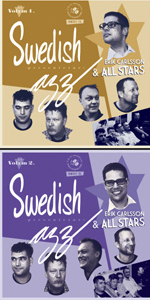 A quintet of Scandinavian musicians, Erik Carlsson & All Stars use an even more venerable configuration for their recreation of so called Swedish [j]azz of the 1950s and 1960s: the 10-inch LP. The appeal of these one-track-per-side performances on this 2-LP set is how the players stay true to the pieces, pop-bop origins while retrofitting (post)modern sequences. A tune such as the folksy Du Glädjerika Skona is propelled by subtle emphasis from Kjell Nordeson’s vibes plus snorting flutters from Mats Gustafsson’s baritone saxophone and vibrating puffs of Per-Åke Holmander’s tuba until near tactile clatters and scratches sourced from Dieb13’s turntables roguishly interrupts the proceedings. Similarly a treatment of Umepolskan & Nybyggarland links the variable speeds of Nordeson’s motor-driven instrument with Dieb13’s sampled aviary squawks and trills until basso saxophone burps introduce a waltz-like turnaround played straight with supple mallet clicks and rat-tat-tat drumming from Carlsson. Finally the tune exits as a contest between Gustafsson’s barking reed lines and the initial theme propelled by vibes and tuba.
A quintet of Scandinavian musicians, Erik Carlsson & All Stars use an even more venerable configuration for their recreation of so called Swedish [j]azz of the 1950s and 1960s: the 10-inch LP. The appeal of these one-track-per-side performances on this 2-LP set is how the players stay true to the pieces, pop-bop origins while retrofitting (post)modern sequences. A tune such as the folksy Du Glädjerika Skona is propelled by subtle emphasis from Kjell Nordeson’s vibes plus snorting flutters from Mats Gustafsson’s baritone saxophone and vibrating puffs of Per-Åke Holmander’s tuba until near tactile clatters and scratches sourced from Dieb13’s turntables roguishly interrupts the proceedings. Similarly a treatment of Umepolskan & Nybyggarland links the variable speeds of Nordeson’s motor-driven instrument with Dieb13’s sampled aviary squawks and trills until basso saxophone burps introduce a waltz-like turnaround played straight with supple mallet clicks and rat-tat-tat drumming from Carlsson. Finally the tune exits as a contest between Gustafsson’s barking reed lines and the initial theme propelled by vibes and tuba.
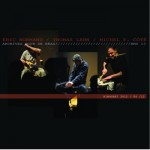 Moving ahead a half century to the second decade of the 21st, and preserved on a far different medium, are concerts recorded at a music festival in Rimouski, Quebec, only available for download. The slyly titled Invisible (Tour de Bras DL #1, tourdebras.com) captures an intense interaction among German analog synthesiser player Thomas Lehn, Montreal percussionist Michel F. Côté and local electric bassist, Éric Normand. Lehn is also present on Sources (Tour de Bras DL #2), but here his playing partner is Montreal-based, American violinist Malcolm Goldstein. Most of Invisible’s 36 minutes is concerned with understated crackles, cackles and clacks, with none of the players outputting expected timbres. Still, a climax of sorts is reached at mid-point, after a klaxon-like blat, likely from Côté noisemakers, cuts through the waves of tripartite soundscapes, presaging emphasized percussion thumps, distorted bass flanges and sweeping oscillations from the synthesizer. Following a prolonged silence, the single track’s latter half is more distant and melancholy with intermittent milk bottle-like pops and door-stopper-like quivers, bass string sluices and jittery synthesizer pulsations fading to obtuse squeaks.
Moving ahead a half century to the second decade of the 21st, and preserved on a far different medium, are concerts recorded at a music festival in Rimouski, Quebec, only available for download. The slyly titled Invisible (Tour de Bras DL #1, tourdebras.com) captures an intense interaction among German analog synthesiser player Thomas Lehn, Montreal percussionist Michel F. Côté and local electric bassist, Éric Normand. Lehn is also present on Sources (Tour de Bras DL #2), but here his playing partner is Montreal-based, American violinist Malcolm Goldstein. Most of Invisible’s 36 minutes is concerned with understated crackles, cackles and clacks, with none of the players outputting expected timbres. Still, a climax of sorts is reached at mid-point, after a klaxon-like blat, likely from Côté noisemakers, cuts through the waves of tripartite soundscapes, presaging emphasized percussion thumps, distorted bass flanges and sweeping oscillations from the synthesizer. Following a prolonged silence, the single track’s latter half is more distant and melancholy with intermittent milk bottle-like pops and door-stopper-like quivers, bass string sluices and jittery synthesizer pulsations fading to obtuse squeaks.
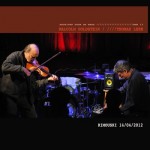 With Goldstein’s so-called classical techniques on show, Sources is a stimulating sashay between two masterful improvisers as the fiddler’s staccato and strident scrubs and stops bring out the humanness of Lehn’s machinery. With bubbling hoedown-like slides, flying spiccato plus multiple jetées sounding concurrently, Goldstein coaxes lightening quick responses from Lehn, which take the form of thick tremolo modulations and grinding processed vamps. Flamboyant enough to intimate a passionate middle sequence studded with stops and strums, the violinist’s exposition eventually blends with the synthesizer player’s processed drones and ring-modular-like flanges to create a conclusion enlivened by Lehn’s unexpected piano-like keyboard expression and staccato string stops.
With Goldstein’s so-called classical techniques on show, Sources is a stimulating sashay between two masterful improvisers as the fiddler’s staccato and strident scrubs and stops bring out the humanness of Lehn’s machinery. With bubbling hoedown-like slides, flying spiccato plus multiple jetées sounding concurrently, Goldstein coaxes lightening quick responses from Lehn, which take the form of thick tremolo modulations and grinding processed vamps. Flamboyant enough to intimate a passionate middle sequence studded with stops and strums, the violinist’s exposition eventually blends with the synthesizer player’s processed drones and ring-modular-like flanges to create a conclusion enlivened by Lehn’s unexpected piano-like keyboard expression and staccato string stops.
Turning on its head McLuhan’s dictum that the medium is the message, these projects prove that exceptional messages can appear in any medium.


